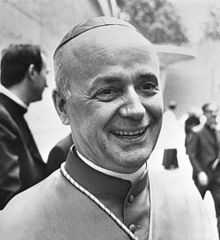Giovanni Benelli
| His Eminence Giovanni Benelli | |
|---|---|
| Cardinal, Archbishop of Florence | |
 Giovanni Benelli in 1978 | |
| See | Florence |
| Installed | 3 June 1977 |
| Term ended | 26 October 1982 |
| Predecessor | Ermenegildo Florit |
| Successor | Silvano Piovanelli |
| Other posts | Substitute Secretary of State (1967–77) |
| Orders | |
| Ordination |
31 October 1943 by Giuseppe Debernardi |
| Consecration |
11 September 1966 by Amleto Giovanni Cicognani |
| Created Cardinal |
27 June 1977 by Paul VI |
| Personal details | |
| Born |
12 May 1921 Vernio, Italy |
| Died |
26 October 1982 (aged 61) Florence, Italy |
| Motto |
Virtus Ex Alto (Power From on High) |
| Coat of arms |
 |
| Styles of Giovanni Benelli | |
|---|---|
 | |
| Reference style | His Eminence |
| Spoken style | Your Eminence |
| Informal style | Cardinal |
| See | Florence |
Giovanni Benelli (12 May 1921 – 26 October 1982) was an Italian Cardinal of the Roman Catholic Church. He served as Archbishop of Florence from 1977 until his death, and was elevated to the cardinalate in 1977.
Biography
Early life and ordination
Giovanni Benelli was born in Poggiole di Vernio, Tuscany, to Luigi and Maria (née Simoni) Benelli. Baptised the day after his birth, on 13 May, he was the youngest of his parents' five surviving children, and his uncle Guido was a revered Franciscan friar. Benelli entered the Seminary of Pistoia in 1931, and then attended the Pontifical Gregorian University and the Pontifical Ecclesiastical Academy in Rome. He received the clerical tonsure on 23 December 1939, and was eventually ordained a priest on 31 October 1943 by Bishop Giuseppe Debernardi. At age 22, he had not yet reached the canonical age of 24 for priestly ordination, and therefore was given a special dispensation. Benelli finished his studies at the Gregorian in 1947, and also undertook pastoral work in Rome until 1950.
Roman Curia
His abilities were noticed by the Church, and he soon became attached to the Roman Curia. Named private secretary to Giovanni Battista Montini on 1 August 1947, Benelli was later raised to the rank of Monsignor on 16 July 1950. He served as the Secretary of nunciatures to Ireland (1950–1953) and to France (1953–1960). Benelli was then appointed to the following posts: auditor of nunciature to Brazil (1960–1962), counsellor of nunciature to Spain (1962–1965), and permanent observer of Holy See before UNESCO in Paris (1965–1966).
Archbishop
On 11 June 1966, he was appointed Titular Archbishop of Tusuro and Apostolic Nuncio to Senegal, as well as apostolic delegate to Western Africa. Benelli received his episcopal consecration on the following 11 September from Cardinal Secretary of State Amleto Giovanni Cicognani, with Archbishop Pietro Sigismondi and Bishop Mario Longo Dorni serving as co-consecrators.
Within a year, on 29 June 1967, he entered the Roman Curia as Substitute, or Deputy, of the Secretariat of State. As Cicognani was too old to fulfill most of his duties, they fell to Benelli. He worked closely with his former master, now Pope Paul VI, and remained in this post for ten years.
Some referred to him as "the Berlin Wall"[1] and the "Vatican Kissinger"[2] in the Vatican for his aggressive and almost authoritarian tenure as Substitute of the Secretariat of State, including having the more senior Curialists channel business through him.
Benelli was promoted to Archbishop of Florence on 3 June 1977, and was created Cardinal-Priest of Santa Prisca by Paul VI in the consistory of 27 June 1977.
Papabile
Upon the deaths of Popes Paul VI and John Paul I, Benelli was considered the leading moderate candidate to succeed them, because of his close ties with Paul and his Italian heritage. He was one of the cardinal electors in the conclaves of August and October 1978, though did not manage to gain enough votes to ascend the Chair of Peter. During the August conclave, Benelli supported Albino Luciani, the eventual winner.[3][4]
Later life and death
Benelli continued in his capacity of Cardinal Archbishop of Florence until he died of a sudden heart attack in Florence, at age 61. His funeral Mass was celebrated by Cicognani's successor, Agostino Casaroli, and his remains were buried in Santa Maria del Fiore cathedral.
See also
- The Last Confession, a stage play where Benelli is the lead character.
References
Notes
- ↑ The Pope's Powerful No. 2. TIME. Published: 14 March 1969. Archived: 5 June 2008.
- ↑ Time Magazine. Recent Events 8 November 1982
- ↑ Time Magazine. In Rome, a Week off Suspense 28 August 1978
- ↑ Time Magazine. A Swift, Stunning Choice 4 September 1978
Bibliography
(1976) Pancorbo, Luis: "Monseñor Benelli" en "Diálogos italianos". pp. 343–353. Sedmay, Madrid. ISBN 84-7380-124-5 (in Spanish)
External links
| Wikimedia Commons has media related to Giovanni Benelli. |
| Catholic Church titles | ||
|---|---|---|
| Preceded by Angelo Dell'Acqua |
Substitute for General Affairs 29 June 1967 – 3 June 1977 |
Succeeded by Giuseppe Caprio |
| Preceded by Ermenegildo Florit |
Archbishop of Florence 3 June 1977 – 26 October 1982 |
Succeeded by Silvano Piovanelli |
|